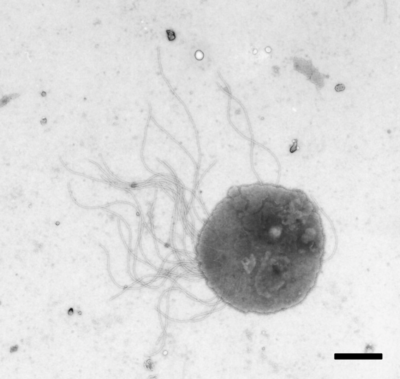FAST and splitFAST in Archaea! J. Bacteriol. 2022 just reports a team of the University of Minnesota implementing those in Methanococcus maripaludis. Furthering bacteria and eukaryots, this step opens a brand new domain for The Twinkle Factory.
Terry Papoutsakis of University of Delaware initially disclosed the potential of FAST for fluorescence labeling of anaerobic bacteria. Indeed a lasting challenge for scientists since the invention of fluorescent proteins! Since the initial Clostridium acetobutylicum, teams from Ulm and Nottingham have equipped further anaerobes, namely Eubacterium limosum, C. saccharoperbutylacetonicum, Acetobacterium woodii. Those are candidates to produce biofuels or chemicals from wastes and fatal biomass, e.g., ethanol, butanol, butyrate, lactate and PLA (poly-lactic acid). They would be cornerstones of the upcoming and much-needed CarbonSmart world. Enriching their genetic toolbox, FAST and splitFAST will hence enable and expedite strain engineering into effective cell factories.
Besides, FAST proved powerful for the investigation of oxygen-limited biofilms comprising of E. coli, Bacillus thuringiensis, Pseudomonas fluorescens, Kocuria varians, Rhodocyclus sp. Eventually, FAST was also applied in the anaerobic protozoan, Giardia intestinalis, hence showing its immense versatility.
This is when comes Methanococcus maripaludis, a methanogenic archaea. They are important members of anaerobic microbial communities where they catalyze essential reactions in the degradation of organic matter. So far, in methanogenic archaea as earlier in anaerobic bacteria, live cell fluorescence imaging has been limited due to the strictly anoxic growth conditions and autofluorescence.
In this recent paper, Eric Hernandez and Kyle Costa show the successful implementation of FAST in the most anoxic conditions. Indeed, examples include protein abundance analysis, subcellular localization, and determination of protein-protein interactions. Beside FAST, they also implemented derivatives such as splitFAST, a bimolecular complementation system, and tdFAST, a tandem tag. As a result, their work paves the way to a revolution in microscopic studies of anaerobic archaea.
The Twinkle Factory offers commercial fluorogens for FAST and splitFAST. tfFox-NP, a bright non-permeant fluorogen, and tfDarth, a “dark” chromophore, have recently completed the product range.
More reading on anaerobe labeling with FAST
- Appl. Microbiol. Biotechnol. 2022 – Autotrophic lactate production from H2 + CO2 using recombinant and fluorescent FAST-tagged Acetobacterium woodii strains – Ulm University and University of Nottingham
- ACS Synth. Biol. 2022 – Establishment of Green- and Red-Fluorescent Reporter Proteins Based on the Fluorescence-Activating and Absorption-Shifting Tag for Use in Acetogenic and Solventogenic Anaerobes – Ulm University
- Biotechnol. Biofuels 2021 – Production of the Biocommodities Butanol and Acetone from Methanol with Fluorescent FAST-tagged Proteins using Metabolically Engineered Strains of Eubacterium Limosum – Ulm University
- BMC Biology 2021 – Access Inheritance of the reduced mitochondria of Giardia intestinalis is coupled to the flagellar maturation cycle – Charles University Prague
- Curr. Opin. Biotechnol. 2021 – Anaerobic fluorescent reporters for cell identification, microbial cell biology and high-throughput screening of microbiota and genomic libraries – University of Delaware
- npj Biofilms Microbiomes 2021 – Four species of bacteria deterministically assemble to form a stable biofilm in a millifluidic channel – Sorbonne University
- Appl. Environ. Microbiol. 2019 – A Strongly Fluorescing Anaerobic Reporter and Protein-Tagging System for Clostridium Organisms Based on the Fluorescence-Activating and Absorption-Shifting Tag Protein (FAST) – University of Delaware

Recent Comments